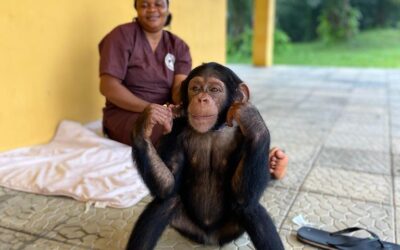How Can You Reduce Climate Change by Helping Protect Great Apes?
New Data Show that Climate Change Is Causing Massive Tree Die-Offs in Africa
By Natasha Tworoski
It’s hard to find a place on the planet where scientific evidence isn’t showing global climate change taking a drastic toll on wildlife and ecosystems. Tragically, this includes the lush forests of Africa and its diverse wildlife.
Africa’s Congo Basin is the second largest rainforest in the world, reaching across six countries, and is home to the greatest number of primates, mammals, birds, fish and swallowtail butterflies of any region of Africa. It also hosts Africa’s second longest river, the Congo River, an important source of water for wildlife and people. Like so many wild places, the Congo Basin is an indicator of the dramatic changes our planet is now undergoing.
NASA satellite imaging and the highly sensitive Enhanced Vegetation Index can reveal the amount of greenness, an indicator of forest health. While the loss of vegetation, referred to as “browning,” has been occurring in the Amazon at a rapid rate, imaging recorded in 2014 showed browning in the Congo Basin is now a major concern there as well. Increasing land surface temperatures and decreased cloudiness are causing large scale tree mortality, which in turn exposes more of the Earth’s surface to the effects of rising temperatures, increasing the rate of climate change.
With deforestation already a huge threat to wildlife in the Congo Basin, this evidence that the remaining forest is deteriorating due to climate change is disheartening news.
A new horrifying threat has just been published this week in the highly respected peer-reviewed journal Nature. Satellite imaging of the Congo Basin’s Cuvette Centrale peat lands, which exist across the Republic of Congo and the Democratic Republic of Congo, have been found to hold 30 billion tons of carbon. This amount is equivalent to 3 years of global emissions. While peat lands only cover 3% of the planet’s surface, they are responsible for one third of soil carbon. The frightening problem comes when peat lands are dug up, usually to create new farm land, and the carbon is released from the earth and into the atmosphere. While the Cuvette Centrale peat lands are not yet being destroyed, the rapidly growing trend of palm oil plantations in Africa mean this could be a very real risk in the near future.
Fortunately, the Cuvette Centrale peat lands are located in a region that is highly inaccessible, which is likely the reason they have not been disturbed to date. The peat lands also have a champion in their corner – this area is home to one of the highest densities of gorillas in Africa.
By protecting one of our closest relatives and their habitat, we are also protecting all of us from the devastating effects of climate change.
Please donate today to help protect African primates and their habitat – before it’s too late.

Protecting an area with the largest concentration of gorillas in Africa also prevents disruption of peat lands, a major risk for release of carbon into the atmosphere.
Next Posts
Rewilding Bonobos: 14 Bonobos Return to the Wild
After years of planning and preparation, 14 bonobos are back where they belong in the lush rainforest of equatorial Africa!
Social Media and Wildlife Trafficking
Social media enables a cycle of cruelty and suffering for primates and other wildlife. But you can help protect animals.
Wildlife Policy Overview: What is CITES and how does it help primates?
CITES, an international trade agreement, has a big impact on PASA members’ work. Here’s how it shapes wildlife policy and sanctuary practice.
Wildlife Crime Won’t Stop Him
Héritier Mpo helps PASA members in DRC rescue apes and monkeys. After wildlife criminals torched his offices he must rebuild.
Trophy Hunting Poses Threat to African Primates
PASA member sanctuaries rescue and care for both monkeys and apes. Although all primates have similarities, monkeys and apes differ in their appearance, geography, and intelligence.
Monkeys vs Apes: How are they different?
PASA member sanctuaries rescue and care for both monkeys and apes. Although all primates have similarities, monkeys and apes differ in their appearance, geography, and intelligence.
Four Chimps Find Sanctuary
Through the global pandemic, and even a coup attempt, PASA and our partners did not give up on these chimpanzees – read the amazing story!
Primate Species Spotlight: The Spot-Nosed Guenon
Get to you know Africa’s remarkable monkeys. Today we feature the spot-nosed guenon, a species found throughout Africa.
A Coalition to Disrupt the Illegal Wildlife Trade
The climate crisis is devastating African primates. Our new report investigates – and shows how sanctuaries are fighting back.
Sanctuaries in Africa Face Water Shortages
Sanctuaries and their communities are facing increased water shortages in Africa. That’s why PASA is working to find water access solutions.










